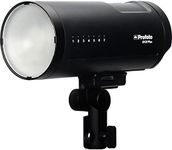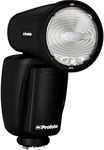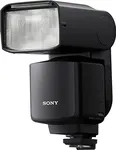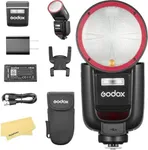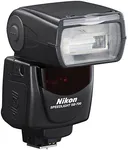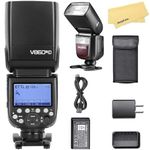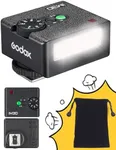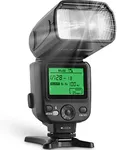Buying Guide for the Best Camera Flashes
Choosing the right camera flash can significantly enhance your photography by providing better lighting, reducing shadows, and allowing for more creative shots. When selecting a camera flash, it's important to consider several key specifications to ensure it meets your needs and complements your camera and shooting style.Guide NumberThe guide number (GN) indicates the power of the flash. It is a measure of the maximum distance the flash can effectively illuminate a subject. A higher guide number means a more powerful flash that can light up subjects farther away. For general photography, a GN of around 20-30 is usually sufficient. For more demanding situations, such as outdoor or large venue photography, a GN of 40 or higher may be necessary. Choose a guide number based on the typical distance between you and your subjects.
Recycle TimeRecycle time is the duration it takes for the flash to recharge and be ready to fire again after a shot. This is important for continuous shooting and capturing fast-moving subjects. Shorter recycle times (1-2 seconds) are ideal for action photography and events where you need to take multiple shots in quick succession. Longer recycle times (3-5 seconds) may be acceptable for more controlled environments like studio photography. Consider your shooting pace and the type of events you cover when evaluating recycle time.
Flash DurationFlash duration refers to the length of time the flash emits light. Shorter flash durations (1/1000 to 1/20000 of a second) are better for freezing fast-moving subjects, making them ideal for sports or wildlife photography. Longer durations (1/200 to 1/1000 of a second) are suitable for general use and portrait photography. Think about the types of subjects you photograph most often to determine the appropriate flash duration.
TTL (Through-The-Lens) MeteringTTL metering is a feature that allows the camera to automatically adjust the flash output based on the exposure settings and the amount of light passing through the lens. This is important for achieving well-balanced exposures without manual adjustments. If you prefer a more hands-off approach or shoot in varying lighting conditions, a flash with TTL metering is highly beneficial. For those who like to have full control over their lighting, manual flashes without TTL can be a good choice.
Swivel and TiltSwivel and tilt capabilities allow the flash head to be adjusted in different directions. This is crucial for bouncing light off walls or ceilings to create softer, more diffused lighting. A flash that can swivel 180 degrees and tilt up to 90 degrees offers the most flexibility. If you often shoot indoors or in situations where you need to manipulate the direction of light, a flash with good swivel and tilt range is essential. For straightforward, direct lighting, these features may be less critical.
CompatibilityCompatibility refers to whether the flash can work seamlessly with your camera model and brand. This is important to ensure all features, such as TTL metering and wireless control, function correctly. Check the manufacturer's specifications to confirm compatibility with your camera. If you use multiple camera brands or plan to upgrade in the future, consider a flash with broader compatibility or one that supports firmware updates.
Wireless ControlWireless control allows you to trigger the flash remotely, which is useful for off-camera lighting setups. This is important for creative lighting techniques and more complex setups. Look for flashes with built-in wireless capabilities or those that can be paired with wireless triggers. If you frequently use multiple flashes or need to position your flash away from the camera, wireless control is a valuable feature. For simpler setups, this may not be as necessary.
